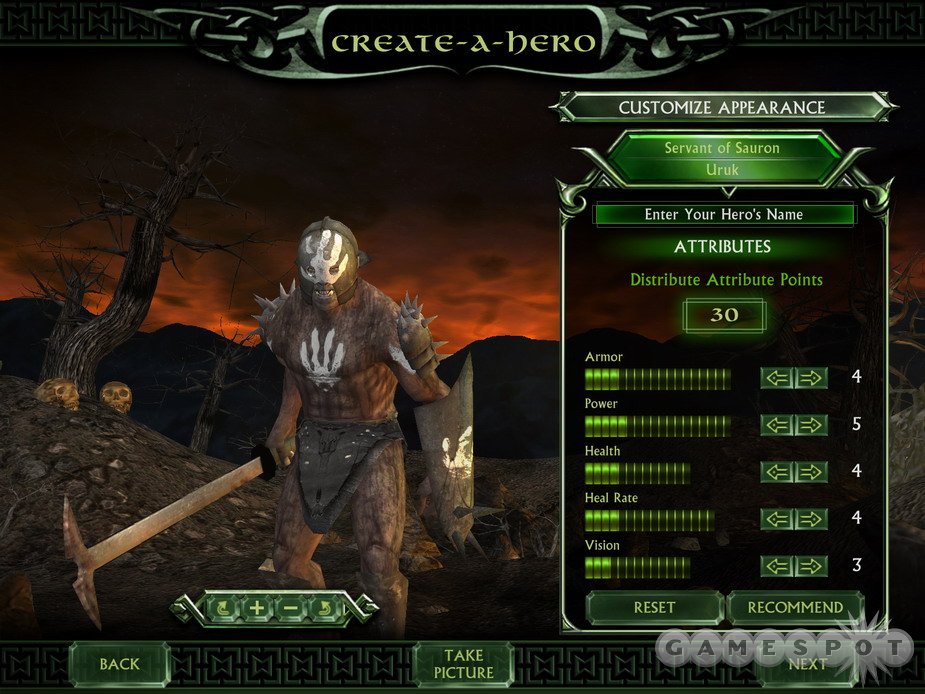The Lord of the Rings, The Battle for Middle-earth II Q&A - Create-a-Hero
We talked to a producer to get the details on the new create-a-hero feature in The Battle for Middle-earth II and to learn how you'll be able to put yourself in the game like never before.
With The Lord of the Rings, The Battle for Middle-earth II due out in stores next month, EA has begun to describe in detail many of the new gameplay features to be found in this sequel. One of the major new additions is the create-a-hero feature, which will let you create your own avatar in the game. You can use this feature to potentially create a version of yourself to battle alongside--or to fight against--the major characters of The Lord of the Rings. To learn more, we caught up with associate producer Amir Rahimi.

GameSpot: What was the idea behind adding the create-a-hero feature in Battle for Middle-earth II? Was it something that fans demanded? How does it improve the overall game?
Amir Rahimi: The Battle for Middle-earth II provides the deepest hero customization of any real-time-strategy game to date. There are two big ideas behind create-a-hero. First, we wanted to give people a way to create their own avatars in the world of Middle-earth. By providing several available classes and races, plus options for customization that range from clothing to skills, we give players a way to define their own heroes--to ask and answer the question, “What hero would I be in Middle-earth, and what would I look like?” The second big idea is customizable units. Imagine being able to create your very own unit that favors your strategy and style of play. Heroes are very powerful units, and now players can control how they move, heal, fight, and level up with special abilities and powers.
GS: To what extent can you customize your hero? Can you select race, gender, and class, like you can in a role-playing game? What aspects of the create-a-hero feature really distinguish it from other customization options that we've seen in other games?
AR: When creating a hero, you get to choose from some of the most fascinating races and creatures in all of Middle-earth, including elves, dwarves, orcs, uruk-hai, men, wizards, and even trolls. There are six classes, and each class offers at least two subclasses, or types. For example, if you select the "servant of Sauron" class, you can then choose to be an orc, uruk-hai, or troll. Once you've picked a class and type, you get to customize your hero's appearance by choosing helmets, armor, clothing, weapons, boots, shields, and other elements that change the look of the hero. You can even change the color of some of your hero's clothes and gear if you so desire.
Most of the armor and gear options we offer in create-a-hero were created based on production stills from the Lord of the Rings films. The costume detail from the movies is astonishing. You can choose to equip your characters in very authentic costumes. For example, you can create a rohirrim that looks like he popped right off the movie screen by choosing a "hero of the west" and equipping him with the right Rohan gear, including the appropriate helmet, armor, shield, sword, and boots. Or you can mix and match elements from various regions and cultures and create a unique style for your hero. It's all up to you.
GS: Could you describe the skill system to us, and perhaps give us an example of some initial skills a custom hero would start with?

AR: Once the look of the hero has been defined, the player then gets to distribute a certain number of points across various attributes such as power, speed, and stamina. Then, the player gets to choose the powers that the hero will have. We offer the best powers from Battle for Middle-earth and Battle for Middle-earth II, as well as some very interesting powers that were created exclusively for this feature.
The choice of powers is determined by the class of hero. For example, the wizard class will have access to powerful magical abilities, such as teleporting enemies, firing off spell blasts, or summoning fireballs. At the highest levels, wizards can generate and channel huge amounts of energy with powers that rival Gandalf's "word of power." Corrupted men, on the other hand, deal in treachery. They get to choose powers like stealing money from opponents, disguising themselves as enemy soldiers, and assassinating enemy heroes by stabbing them in the back.
GS: When you outfit a hero with armor and weapons--such as choosing to carry a sword or a war-hammer into battle--is it merely cosmetic, or will the choices you make have a difference in the game? Will you be able to upgrade or recover better items throughout the game, and will it affect your character's appearance?
AR: Armor, weapon, gear, and clothing options only affect the appearance of the hero. The strategic decisions are made when customizing the hero's attributes and powers.
GS: What happens if your character is "killed" in battle? Do you simply resurrect at the fortress like you can with other regular hero units? Is there a penalty of any kind? Are your kills and deaths recorded somewhere?
AR: During a match, the created heroes function just like all other heroes. If they are killed, they can be resurrected at the fortress. But unlike regular heroes, we keep track of a multitude of statistics for each created hero, including the number of times the hero has been killed.
GS: There seems to be a sense of persistence with your hero, as the game will keep track of your hero's record and accomplishments in single-player. Will it do the same for multiplayer as well?
AR: More than 60 statistics are tracked for each created hero. Stats range from the number of kills and deaths in each game mode (skirmish, multiplayer, and war of the ring) to how many of a particular hero or unit type each created hero has killed. On top of that, the player can earn awards for completing various objectives with their hero (such as killing a balrog, or conquering Middle-earth in war of the ring mode).

GS: Finally, do you have any favorite custom heroes? Which are they, and why are they your favorites?
AR: As a real-time-strategy player, my biggest weakness is micromanaging units to win battles. Therefore, I created a captain of Gondor called Amiragorn and gave him powers that would give me the edge in critical skirmishes, such as summoning armies, providing leadership buffs, and temporarily gaining the ability to crush enemy units. I also really enjoy creating evil men because I love the look of easterling and haradrim armor. I like coming up with unique and interesting combinations of clothing, weapons, and armor from these two cultures. It's also great fun to pick a bunch of sneaky underhanded powers that will add insult to injury in a battle.
GS: Thanks, Amir.
Got a news tip or want to contact us directly? Email news@gamespot.com
Join the conversation